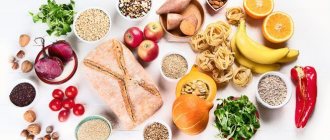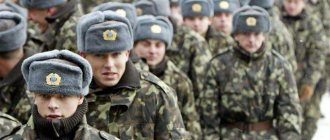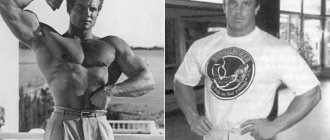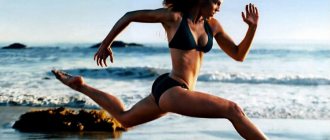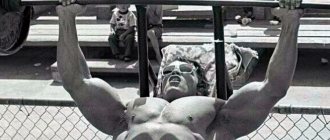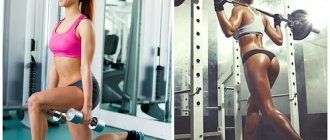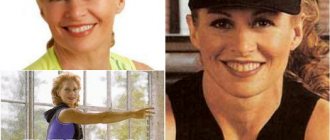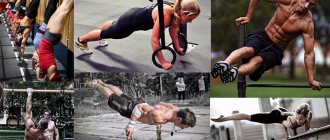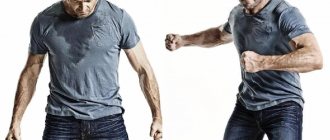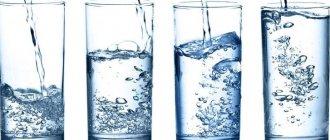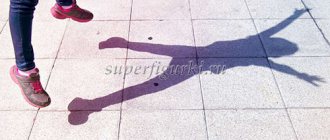Start your journey to a perfect body with these simple workouts for beginners.
If you feel that your figure has deteriorated, then it’s time to get off the couch and go to the rocking chair.
To effectively get back into shape, you need to start somewhere. This is where our training program for beginners will help you, or rather two complexes, one for training in the gym, the other at home.
Here are just a few reasons to get into fitness:
- Feel more self-confident - your quality of life will improve thanks to your excellent physical condition
- Your mood will improve - you will forget about mood swings and feel like an alpha male.
- Improve your sex appeal - be the one who attracts the attention of all the women around you.
If you are reading this article, then you most likely have just found a gym and fitness for yourself.
But without the right knowledge, you won't be able to gain mass and strength as quickly as you could. This is why some people simply give up after two or three months or simply don't achieve their desired goal.
But there's no need to be hesitant, because below is a clear guide to training for beginners that you can get started with right away.
How to start practicing?
First you need to decide what exactly you are trying to achieve.
Do you want to build muscle mass? Are you training to compete in bodybuilding competitions? Or just want to improve your health and self-esteem?
Once you define the purpose of your exercise, it will be easier for you to progress and stay motivated.
Record your results
Recording your results is another essential component when you first start training. This will help you understand where you are moving and whether you are moving at all.
There are applications for smartphones that will help you with this, as well as fitness trackers, which are so popular now and the very first workout should be displayed in it in order to see all the results and achievements, which will then become an additional incentive to continue playing sports.
Rest
Rest is also very important when it comes to muscle growth and strength. Some people may decide that they need to go to the gym twice a day, seven days a week.
But your body needs time to recover from a difficult workout in the gym or at home, which is something you need to remember.
They say that it's a matter of regularity, but you also have to remember that you can't achieve everything in one day. We must go slowly but surely.
Small, high-quality meals
It's not that simple. Nutrition is no less important than sleep. Go.
Train yourself to eat 6-8 times a day! This is necessary to speed up your metabolism (metabolism). You will be able to get more from your food. The body will absorb nutrients better! If you starve, you won’t get pumped up! I'm telling you exactly!
Remember that there are two phases in bodybuilding! The muscle mass gain phase and the cutting phase (anabolism and catabolism, respectively). Combining these two phases is impossible! Either you're bulking up or you're drying out! If there is no muscle mass, then there is no point in drying out!
Sample diet for building muscle mass:
- Meat (any), chicken, fish about 500 g per day
- Milk (about 300-500 g), eggs (6-10 pcs), cottage cheese (200 g), kefir (300 g).
- Rice, Buckwheat, potatoes, vegetables (fresh, boiled, etc.) approximately 500 g.
- Drink plenty of water! I talked about this in this article. During training and throughout the day! At least 2 liters per day! Remember, minimum! Buy yourself a shaker (250-500 rubles). Pour water into it and drink while studying, at home, or while training. Everywhere! The bigger, the better! There is never too much water.
By the way, I posted a lot of cool and simple recipes in an article about protein shakes at home for a set. There are protein shakes for weight loss that you can easily prepare at home.
Understand that to become bigger you need to get out of your comfort zone. Those. you won’t be able to eat either! We need to eat more! To trigger high-quality anabolism, you must eat a lot, i.e. there must be a calorie surplus! Belly fat, etc. may even appear. It's all bullshit! It will all go away quickly during drying! Moreover, the more muscle there is, the faster it will burn!
For example, like this:
- 07:40: Drank a mug of water
- 8:00: Ate oatmeal, cheese sandwich, 2 eggs.
- 10-11 o'clock: A piece of chicken, an egg, rice.
- Lunch: Chicken or meat, rice, vegetables, egg, washed down with milk.
- After school or work, before training (15-16 hours): vegetables and a couple of eggs, so as not to overload and not have a hard time, or, better yet, drink a protein shake! Delightfully digestible and very useful!
- After the workout, we ate meat, vegetables, a couple of eggs, milk (carbohydrates, such as rice, etc., are better not worth it, they will go into fat and the body won’t have time to use them up).
- Before going to bed (at night): a pack of low-fat cottage cheese (200 g) and a mug of kefir! Recommendation: buy cottage cheese no cheaper than 45-50 rubles, otherwise you will simply eat coconut fat or other contamination.
- Plus, take some multivitamins!
The basic circuit will look something like what I indicated above.
You will find this difficult! Naturally! It is not simple! But I’ve been eating this way for a very long time and it’s bringing results! This must be hard! That's the whole point! To get bigger, you have to eat more and progressively lift!
To become something you haven’t been, get ready to do something you haven’t done!
You can vary the products differently, don’t be afraid! The main thing is to eat more often! 6-8 times will be great! Just opened the vacuum container, ate a couple of pieces of meat with cucumber and it was fine). Then a little more!
Is it better to go to the gym or work out at home?
Chances are there is a gym near your home that you can go to for a small monthly fee. There you will have access to many sports equipment - both free weights and exercise machines - everything you need for sports.
But for those of you who don’t want or can’t come to the gym, all of the benefits listed are also available. Everything can be achieved without leaving home, you just have to spend a little more money.
Training with weights or resistance bands
Dumbbells and kettlebells can be found at low prices, especially if they are second-hand. If you have some free space, then this is the best and most effective option for the price.
Resistance bands are also a good option, as they give you a convenient way to do exercises that tone and strengthen your muscles.
Body weight exercises
You can do exercises without equipment. These exercises use only your body weight. For beginners, these are one of the best options as they are simple yet effective. They can achieve more than you expect!
Psychology of Forex Trading
The psychology of Forex trading helps a trader fight his main enemies. They all live in our head. Greed is danger number 1. Everything here is good in moderation. If a trader is too greedy, he misses a lot of opportunities to make money. Profitable transactions remain, but their number and volumes are gradually decreasing. When greed takes over, the number of unnecessarily risky trades increases sharply. The result of uncontrolled behavior is partial loss of the deposit or complete ruin. The best way to overcome greed and other emotions is to learn to control and suppress them.
What type of workout should you choose?
All training schemes can be divided into two main types - cardio and strength. For best results, it is recommended to do both equally.
High and low intensity cardio
There are two ways to do the same cardio workout - high intensity and low intensity. High-intensity cardio involves short periods of intense work followed by a short rest. The entire complex lasts 10-30 minutes. This type of training is known as interval training.
Low-intensity training involves performing exercises at a constant low speed for 30-60 minutes.
There are studies that find equal benefits to both types of training, so you should try both and find yours. However, high-intensity exercise is known to provide more benefits in less time.
Strength exercises
In the field of strength training, beginners are more suitable for complexes for pumping all the muscles of the body in one day. Splits into different muscle groups are suitable for more experienced athletes.
Times of the English language.
Even the most extensive vocabulary will not be able to provide full communication in English. English grammar is an important part of learning. In order to master the English language from scratch on your own, you must understand the tense system of the English language. Despite the apparent bulkiness and multi-layered nature, this system, upon closer examination, is quite logical and understandable. A set of grammatical rules will help you construct sentences correctly and express yourself in a foreign language. There are nine basic tenses in English - three present, three past and three future. These tenses are divided into three groups - a group of simple tenses, a group of long tenses and a group of completed tenses. Each group has similar characteristics that distinguish them from each other. All these nine times can be placed in the following table:
| Present (present) | Past | Future | |
| Simple | 1 verb form | 2 verb form | will + 1 verb form |
| Continuous | am (is, are) + verb ending in ing | was (were) + verb ending in ing | will be + verb ending in ing |
| Perfect (completed) | have (has)+ 3 verb form | had + 3 verb form | will have + 3 verb form |
Even when looking at such a simplified tablet, common features and patterns between groups and times are visible. The tenses of the Simple group denote regular, ordinary actions. Times of a long (Continuous) group - actions occurring at a certain moment. Times of a completed (Perfect) group - actions completed at a certain point.
In addition to these main tenses, there are several more that combine the characteristics of different groups. But if you have a good grasp of these nine, the extra tenses will no longer be difficult, and you will easily implement them into your conversation.
What diet is best to follow?
It's no secret that a proper diet is essential to achieving your fitness goals. No one has ever gained muscle or lost fat while still eating three Big Macs a day.
A healthy and balanced diet is necessary to maintain an active lifestyle, and a training program for beginners in the gym should begin with a competent diet. Many people know that muscles are forged in the kitchen!
Watch the amount of protein you consume, as protein is what stimulates muscle growth. But healthy fats and complex carbohydrates also help you train as well as recover. Greens and vegetables are very useful right now.
Where do I begin?
We’ve sorted out the choice of a gym and what we need to pack with us, and now let’s get down to what causes the greatest fear and “evaporates” newcomers from hundreds of gyms.
Namely: beginners have little idea of exactly how to train!
How many approaches, repetitions need to be done, how this or that muscle works, etc. It is not entirely clear how to eat, how much, what foods to exclude, etc. But the most important thing is how to create a training program for yourself. Let's figure it out.
Watch your calories
It is also important to know the number of calories you consume. This can help you reach your goal faster. There are various websites with programs for counting calories. It is important to consider the purpose of fitness classes here.
If you need to maintain your weight, then you should eat only as many calories as you burn. What if you want to lose weight? You need to burn more calories than you consume.
Lastly, if you want to gain weight, you need to eat more than you burn. It's so simple!
Articles of the English language
There are function words in English that are not in Russian. These are articles. The article defines the noun and is of two types - definite (the) and indefinite (a/an). The names of the articles themselves contain their meaning. To speak English confidently, you need to learn how to use this grammatical category.
The indefinite article a identifies a singular countable noun that is mentioned for the first time in speech. Nothing is known about it and it is one of a number of similar items. A has a variation - before nouns starting with a vowel sound, it has the form an.
If speakers understand from the context what object is being discussed or this noun has already been mentioned in previous sentences, then the article the is placed in front of it. The use of the definite article is not limited to singular countable nouns. It can appear before both uncountable nouns and plural nouns.
There are many nuances of using articles, which are studied gradually.
Warm-up and cool-down
It is very important to properly prepare the muscles, ligaments and the entire body for training, be it working with light dumbbells to warm up before moving on to working sets with heavy weights or just light cardio.
Don't have a treadmill? No problem. Just do some jumping jacks, do some bodyweight exercises like squats or push-ups, and do some stretching. All this will be very useful for you because it will help you avoid injury.
It is also important to end your workout correctly so that your heart rate drops to normal speed. Five to ten minutes is usually enough to complete the class.
For example, you can walk for a few minutes at a slow speed on a treadmill or bike.
Forex trading for beginners
All Forex trading for beginners comes down to finding answers to questions such as: “When will the price start to rise or fall?”, “When is it more profitable to buy or sell a currency?” and the like. This part of the work is considered the most difficult. Typically, one or more methods are used to find solutions. All of them are combined into a whole science - this is “Technical Analysis”. The developed methods boil down to analyzing the quote chart by calculating the values of individual indicators. To obtain the most accurate forecast results, Technical analysis is combined with Fundamental analysis (macroeconomic indicators).
Gym training program for beginners
Working with push and pull exercises for arms and exercises for legs, for beginners
Who is this workout for?
This schedule is intended for beginners - it is a fairly simple scheme for three days of training per week. In this schedule, the exercises are divided into rows, presses and leg exercises.
This beginner's gym routine will put you on the path to growth and help you build muscle and lose fat.
How to perform exercises in this scheme?
Each exercise is performed in 2-3 sets of 10-15 repetitions. You should rest for 2-3 minutes between sets.
If you cannot do the specified number of sets and repetitions, then you have chosen too much weight and need to reduce it. If you feel that you can do much more than indicated, for example, 4 or more repetitions, then the weight of the apparatus or on the machine is too small.
Also remember to use the correct technique for performing all movements to avoid injury and progress faster.
Divide your week into training days and rest days so that you rest at least one day after each workout.
Day 1 - Presses
- Incline Bench Press
- Dumbbell curls
- Dumbbell raises
- Army press
- Close grip press
- Triceps push-ups
Day 2 – Deadlifts
- Upper block pull
- Lower block thrust
- Straight arm row
- dumbbell raises
- Barbell Curl with EZ Bar
- Dumbbell curl (hammer)
Day 3 - Legs
- Squats
- Romanian deadlift
- Leg press
- Leg bending in the simulator
- Lunges with dumbbells
- Standing calf raise
Scales in positions
A position or box is a certain area of the fretboard, usually within 4–7 frets, in which the scale fingering is built.
Scales in position are played not only from the tonic, but also from other degrees, depending on the location of the sounds on the fretboard. There are different construction systems: 5 positions (linked to the main fingerings of major or minor chords), 7 positions (from each degree).
Next, let's look at how scales are played on a guitar in the boxes that are most often used. They will be useful to you not only for practicing technique and studying the structure of scales, but also when learning solos, riffs, for writing your own guitar parts, and transcribing parts of other instruments for guitar.
Major
Still the same C major, but in positions: 1 box – from the 1st step (C), 2 – from the 2nd step (D), 3 – from the 3rd (E), 4 – from the 5th (G), 5 – from the 6th (A).
A detailed analysis of these boxes and their use for playing the major scale in different keys is in this article.
Minor
Minor scale in 5 positions.
For parallel (paired) keys, major and minor with the same key signs (see keys on the circle of fifths), the fingerings are the same, but the arrangement of the steps is different, relative to the tonic of the major and minor modes. For example, for C major and A minor: in the C major scale the position from the tonic is on the 8th fret, but in the A minor scale the same position (on the 8th fret) is obtained from the third degree of the minor scale.
For a detailed analysis of the minor scale in 5 positions, see here.
Pentatonic scale
Pentatonic major, minor – scale of 5 notes. Widely used by guitarists in blues, many styles of rock, and jazz.
For details on how to play the pentatonic scale in five positions on the fretboard, see here.
Blues
Almost the same fingerings in positions as for the pentatonic scale, but with the addition of a blue note (according to the steps of the scale, this is the fifth lowered degree (b5) or, in another notation, the fourth raised one (#4)). For example, the A minor blues note is Eb/D#.
Learn how to play the blues scale in 5 positions in this article.
Three notes per string
The peculiarity of these fingerings is that three notes of the scale are played on each string. This approach is often used in high-speed technology.
Seven boxes using the G major scale as an example - from each degree:
- III fret – from G – 1st degree (tonic);
- V fret – from A (2nd step);
- VII fret – from B (3);
- VIII fret – from to (4);
- X fret – from D (5);
- XII fret – from E (6);
- XIV fret – from F-sharp (7).
Home set of exercises for beginners
Here's a program that doesn't require any equipment, so it can be done anywhere, anytime. This is a very good workout for beginners that only requires your body weight.
It combines strength and cardio exercises that train the entire body. They will help you speed up your metabolism.
Who is this workout suitable for?
It's suitable for those who don't have access to a gym or simply want to test their ability with bodyweight exercises before moving on to exercises with free weights or machines.
What does a training split look like?
All exercises are performed in a cycle, 10-12 repetitions for each approach. Rest for one minute between sets. To increase intensity, do more sets or more repetitions.
- Squats
- Jumping jack (30 seconds)
- Push ups
- Lunges
- Plank (30 seconds)
The effectiveness of the program for beginners[edit | edit code]
This training program for beginners is based on an analysis of the literature and is a typical basic scheme. The program is suitable for most beginners, but there are exceptions that cannot be predicted, and only empirical experience will determine them. A much greater risk of low effectiveness arises when using specific programs that are now widely advertised and promoted. Don't be fooled by marketing, as it has been scientifically proven that basic programs like this are the most effective. Don't expect significant results; they will appear only in the third stage. Don't try to force development and skip stages, this will worsen your progress later.
C++ lessons
Useful links:
- Installing Visual Studio;
- Online compiler;
- Great course on C++.
Information about C++
C++ is based on the C language, which was actively developed back in 1969-1973. Bell Labs, led by chief developer Dennis Ritchie, was responsible for the development. Ten years later, Danish programmer Björn Stroustrup, who was once a C developer, releases an expanded version of the language called C++. At the beginning of its journey, C++ was just an extension, a kind of addition to C, which expanded the language by adding OOP principles to it. Stroustrup himself initially viewed the language as just “C with classes.”
C++ was born in 1983. Although it was not a full-fledged language, but only a branch of C, it still had a number of useful functions due to which it became a full-fledged separate programming language. With the release of C++, a number of now common concepts appeared in the world:
- Initiating classes with objects;
- The principle of inheritance in OOP;
- Unloading and deleting functions from memory;
- Creation of virtual functions;
- Exception system and much more.
What about the C language?
The C language remains popular to this day, even despite the development of C++ and the dominant position of the latter language in the field of functionality. Why is an older and less developed language popular even today? It's simple - porting programs to a new language is a rather expensive and time-consuming undertaking. Some companies simply go with the flow and continue to support their C programs.
On the Internet, many experts give advice that it is better to start learning C-like languages with C. They say that this is the only way to better understand the essence of C++. In reality, this is a wrong opinion. If you start learning with C++, the developer will gain knowledge about newer and more modern features of the language. If the need ever arises to switch to C, it will not require much time and effort. Even the very fact of the need to switch to a rather old C already raises serious doubts.
But if you still want to learn C before C++, we suggest you watch a large video lesson in which you can get acquainted with this language:
https://youtu.be/t0_IRViZcHs
You can read more about the language on this page.
Distribution of C++
Soon after its release, the C++ language began to conquer various areas of programming. Gradually, more and more new functions were introduced into it, which increasingly distanced it from the role of an addition to C. Years later, it was no longer considered a continuation or extension and the time came to completely separate from C, and that’s when the language was called C++. Since then, the languages have diverged and they have become independent (as far as possible).
Today, C++ is a functional and powerful language that inherited a lot of key memory management capabilities from C. For this reason, it is actively used in system programming.
A few key areas of use:
- Operating systems development. including the Windows system, which is predominantly based on C++;
- Creation of drivers;
- Writing programs from scratch;
- Development and support of antivirus applications and other things.
C++ has gone far beyond just systems programming. He can participate in the creation of applications of all levels, which focus on speed and work under high loads. It is used to create graphic editors and application applications.
Quite a lot of game engines designed to visualize a huge game world are based on C++. In recent years, more and more mobile applications use this language. Even in the web there is a place for this language. All kinds of web applications actively use C++, not necessarily as a basis, maybe just to implement auxiliary functions, but the fact remains a fact. To summarize: it is harder to find areas in which C++ cannot be used than where this language is used.
Key Features of C++
C++ is a compiled language, meaning the compiler modifies C++ code, converting it into machine language using predefined instructions. All platforms differ in some features, which is why it is impossible to take and transfer a program from one to another platform. More precisely, you can transfer it, but it won’t run there. In this case, the application source code is predominantly transferred. The only exception is the use of specific features of a particular OS.
C++ has compilers and tools for working with code on most well-known platforms. This allows you to compile sources for any platform.
C++ supports writing programs in OOP style, which C does not. In this case, the application becomes just a set of classes, objects that are able to interact with other code elements. This helps in developing large applications.
How did C++ develop step by step?
C++ development steps:
- 1979-1980 – C++ appeared and was positioned as a C language with additional classes;
- 1983 - the language began to be called, as we are all accustomed to, C++;
- 1985 – release of a commercial version of C++. In the same year, the first paper book of the “C++ Programming Language” appeared; it included a description of the functions, capabilities and rules for using the language;
- 1989 – the second version of the language with expanded capabilities was released;
- From 1990 to 2011 – slow development and addition of functionality. It is also worth mentioning that in 1998 they first tried to standardize the language. That standard was later called ISO/IEC 14882:1998, today - C++98. In 2003, the next version of the C++03 standard appeared;
- 2011 – the publication of the C++11 standard, there were really many innovations in it. The update enriched the language with an abundance of useful features;
- 2014 – release of a relatively small addition to the previous version of the standard. It was nicknamed C++14;
- 2017 – the last major release of the language.
Programming environments, compilers
To write a program in C++, a compiler is required, which transforms the original code into one suitable for execution in a file. Today there are an innumerable number of compilers. They differ in a lot of parameters, including the way the standards are implemented. At the compiler selection stage, it is better to choose those that are constantly supported and updated.
To work with C++, you need to install a development environment. You can install any environment convenient for you or even use the online compiler, which is presented on this page below. Among the most popular development environments are: Visual C++, Xcode (Mac only), GCC, Intel C++ Compiler, Embarcadero (Borland) C++ Builder.
Additional courses
You can also look at additional courses on the C++ language. On our website you can find all courses in the C++ language at this link.
